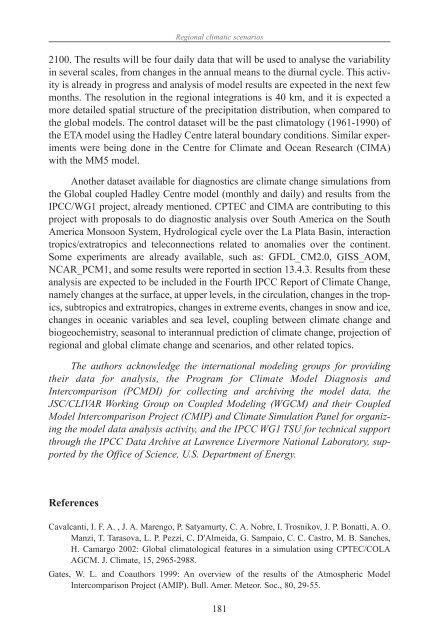chapter - Atmospheric and Oceanic Science
chapter - Atmospheric and Oceanic Science
chapter - Atmospheric and Oceanic Science
Create successful ePaper yourself
Turn your PDF publications into a flip-book with our unique Google optimized e-Paper software.
2100. The results will be four daily data that will be used to analyse the variability<br />
in several scales, from changes in the annual means to the diurnal cycle. This activity<br />
is already in progress <strong>and</strong> analysis of model results are expected in the next few<br />
months. The resolution in the regional integrations is 40 km, <strong>and</strong> it is expected a<br />
more detailed spatial structure of the precipitation distribution, when compared to<br />
the global models. The control dataset will be the past climatology (1961-1990) of<br />
the ETA model using the Hadley Centre lateral boundary conditions. Similar experiments<br />
were being done in the Centre for Climate <strong>and</strong> Ocean Research (CIMA)<br />
with the MM5 model.<br />
Another dataset available for diagnostics are climate change simulations from<br />
the Global coupled Hadley Centre model (monthly <strong>and</strong> daily) <strong>and</strong> results from the<br />
IPCC/WG1 project, already mentioned. CPTEC <strong>and</strong> CIMA are contributing to this<br />
project with proposals to do diagnostic analysis over South America on the South<br />
America Monsoon System, Hydrological cycle over the La Plata Basin, interaction<br />
tropics/extratropics <strong>and</strong> teleconnections related to anomalies over the continent.<br />
Some experiments are already available, such as: GFDL_CM2.0, GISS_AOM,<br />
NCAR_PCM1, <strong>and</strong> some results were reported in section 13.4.3. Results from these<br />
analysis are expected to be included in the Fourth IPCC Report of Climate Change,<br />
namely changes at the surface, at upper levels, in the circulation, changes in the tropics,<br />
subtropics <strong>and</strong> extratropics, changes in extreme events, changes in snow <strong>and</strong> ice,<br />
changes in oceanic variables <strong>and</strong> sea level, coupling between climate change <strong>and</strong><br />
biogeochemistry, seasonal to interannual prediction of climate change, projection of<br />
regional <strong>and</strong> global climate change <strong>and</strong> scenarios, <strong>and</strong> other related topics.<br />
The authors acknowledge the international modeling groups for providing<br />
their data for analysis, the Program for Climate Model Diagnosis <strong>and</strong><br />
Intercomparison (PCMDI) for collecting <strong>and</strong> archiving the model data, the<br />
JSC/CLIVAR Working Group on Coupled Modeling (WGCM) <strong>and</strong> their Coupled<br />
Model Intercomparison Project (CMIP) <strong>and</strong> Climate Simulation Panel for organizing<br />
the model data analysis activity, <strong>and</strong> the IPCC WG1 TSU for technical support<br />
through the IPCC Data Archive at Lawrence Livermore National Laboratory, supported<br />
by the Office of <strong>Science</strong>, U.S. Department of Energy.<br />
References<br />
Regional climatic scenarios<br />
Cavalcanti, I. F. A. , J. A. Marengo, P. Satyamurty, C. A. Nobre, I. Trosnikov, J. P. Bonatti, A. O.<br />
Manzi, T. Tarasova, L. P. Pezzi, C. D'Almeida, G. Sampaio, C. C. Castro, M. B. Sanches,<br />
H. Camargo 2002: Global climatological features in a simulation using CPTEC/COLA<br />
AGCM. J. Climate, 15, 2965-2988.<br />
Gates, W. L. <strong>and</strong> Coauthors 1999: An overview of the results of the <strong>Atmospheric</strong> Model<br />
Intercomparison Project (AMIP). Bull. Amer. Meteor. Soc., 80, 29-55.<br />
181






